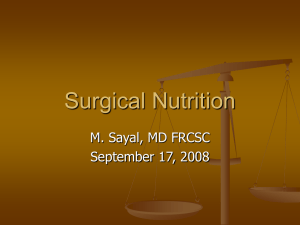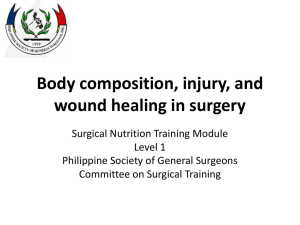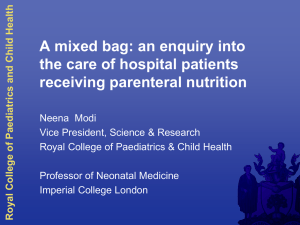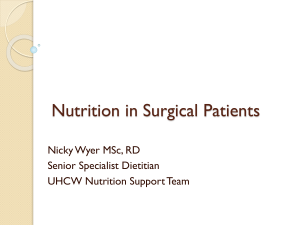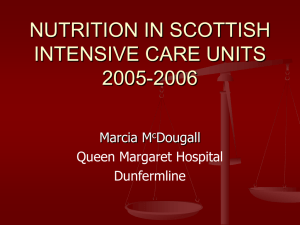Kein Folientitel
advertisement
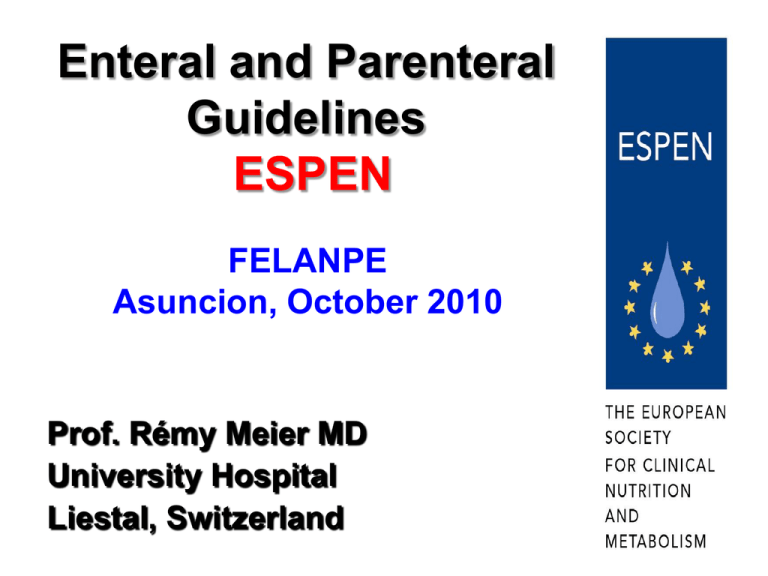
Enteral and Parenteral Guidelines ESPEN FELANPE Asuncion, October 2010 Prof. Rémy Meier MD University Hospital Liestal, Switzerland Research Clinical results Guidelines Aims of the ESPEN-Guidelines The ESPEN-Guidelines „Enteral and Parenteral Nutrition“ aim to assist clinical practitioners, dietitians and nurses who provide enteral and parenteral nutrition support to patients in all care settings as well as to give information to decisionmakers in the health care system Methodology for the development of the ESPEN Guidelines on enteral and parenteral nutrition • Systemic review • Evidence based • Consensus based Manpower EN • 13 disease-specific working groups • 88 experts in clinical nutrition • 20 countries Manpower PN • 11 disease-specific working groups • 87 experts in clinical nutrition • 16 countries Evidence gathering • Structured literature search • Defined search strategy (including criteria, specific key words) • Assessment of the quality and the strength of the literature • Defining the level of evidence • Defining the grade of recommendation The quality and strength of the supporting evidence was graded • According to the criteria of SIGN (Scottish Intercollegiale Guideline Network, No 39, 1999) and • According to the criteria of AHCPR (Agency for Health Care Policy and Research, No 92-0023, 1993) Grades of recommendations and levels of evidence Grades of recommendations A Levels of evidence Ia Requirement Meta-analysis of randomized controlled trials At least one randomized controlled trial Ib B IIa IIb III C IV At least one well-designed controlled trial without randomization At least one other type of well-designed, quasi-experimental study Well-designed non-experimental descriptive studies such as comparative studies, correlation studies, case-control studies Expert options and/or clinical experience of respected authorities The recommendations were not only based on the evidence levels of the studies but also on the judgement of the working group concerning the consistency, clinical relevance and validity of the evidence The preparation and publication of the ESPEN-Guidelines on Enteral and Parenteral Nutrition were exclusively funded by ESPEN Problems with Recommentations ESPEN Guidelines 3 recommentations level A-C but others have 4-5 levels of recommendations A-E ESPEN-EN-Guidelines 2006 Surgery I Recommendation A • Preoperative fasting from midnight is unnecessary in most patients • Interruption of nutritional intake is unnecessary after surgery in most patients • Use nutritional support in patients with severe nutritional risk for 10-14 days prior to major surgery even if surgery has to be delayed. Nutritional risk refers to at least one idem: - Weight loss > 10-15% within 6 months BMI < 18.5 kg/m2 Subjective Global Assessment Grade C Serum albumin <30 g/l (with no evidence of hepatic or renal dysfunction) ESPEN-EN-Guidelines 2006 Surgery II Recommendation A • Patients undergoing surgery who are considered to have no specific risk for aspiration, may drink clear fluids until 2 h before anaesthesia. Solids are allowed until 6 h before anaesthesia • Initiate normal food intake or enteral feeding early after gastrointestinal surgery • Oral intake, including clear liquids, can be initiated within hours after surgery to most patients undergoing colon resections ESPEN-EN-Guidelines 2006 Surgery III Recommendation A • Apply tube feeding in patients in whom early oral nutrition can not be initiated, with special regard to those - undergoing major head and neck or gastrointestinal surgery for cancer - with severe trauma - with obvious undernutrition at the time of surgery • Initiate tube feeding for patients in need within 24 h after surgery • Placement of a needle catheter jejunostomy or naso-jejunal tube is recommended for all candidates for TF undergoing major abdominal surgery ESPEN-EN-Guidelines 2006 Surgery IV Recommendation A • Placement of a needle catheter jejunostomy or naso-jejunal tube is recommended for all candidates for TF undergoing major abdominal surgery. • Use EN preferably with immuno-modulating substrates (arginine, ω-3 fatty acids and nucleotides) perioperatively independent of the nutritional risk for those patients This patients are specified Those patients who benefit are patients - undergoing major neck surgery for cancer (laryngectomy, pharyngectomy) - undergoing major abdominal cancer surgery (oesophagectomy, gastrectomy, and pancreato-duodenectomy) - after severe trauma ESPEN-PN-Guidelines 2009 • What was new ? The recommendations of the EN guidelines were taken and the evidences of parenteral nutrition of each topic were added ESPEN-PN-Guidelines 2009 Surgery I The main goals of perioperative nutritional support are to minimize negative protein balance by avoiding starvation, with the purpose of maintaining muscle, immune, and cognitive function, and to enhance postoperative recovery! ESPEN-PN-Guidelines 2009 Surgery II Recommendation A • Preoperative parenteral nutrition is indicated in severely undernourished patients who cannot be adequately orally or enterally fed • Postoperative parenteral nutrition is beneficial in undernourished patients in whom enteral nutrition is not feasable or not tolerated ESPEN-PN-Guidelines 2009 Surgery III Recommendation A • Postoperative parenteral nutrition is beneficial in patients with postoperative complications impairing gastrointestinal function who are unable to receive and absorb adequate amounts of oral/enteral feeding for at least 7 days ESPEN-PN-Guidelines 2009 Surgery IV Recommendation A • In patients who require postoperative artificial nutrition, enteral feeding or a combination of enteral and supplementary parenteral feeding is the first choice • Weaning from parenteral nutrition is not necessary Recommendations on Enteral Nutrition • Total number of recommendations 226 • Recommendations A = 55 (25%) • Redommendations B = 39 (17%) • Recommendations C = 132 (58%) Recommendations on Parenteral Nutrition • Total number of recommendations 300 • Recommendations A = 48 (16%) • Redommendations B = 94 (28%) • Recommendations C = 158 (56%) Problem! Over 50% of the recommendations are only C „Expert opinions and/or clinical experience of respected authorities“ What has changed? ASPEN Guidelines 1993 - Recommendation A = 16% - Recommendation B = 29% - Recommendation C = 55% Nothing!!!!!! ESPEN 2006/2009 25% 16% 17% 28% 58% 56% There is still a lack of good clinical studies in clinical nutrition!! The guidelines do provide eviencebased information about some specific problems like timing, dosing, composition and route of application, and under which conditions limitation or withdrawal of nutritional support like other therapies might be adequate but they also show where additional studies are needed Genereation of new hypothesis using guidelines • Guidelines shows were no enough evicence for a clear recommendation is available • This can help to design new studies to fill in the missing information Good clinical trials • • • • Db, controlled, randomized trials Adaequate sample size Clear endpoints Single- or multicenter trial Endpoints • Selection of endpoints is crucial! • Mortality is difficult in nutritinal studies (high number of patients needed) • Morbidity is often used • Changes in body composition but • QoL, function, mood, costs …. can be important in special situation Implementation of guidelines Nutritional screening of all patients Nutritional support using guidelines Continuous training Monitoring Regular audits Guideline Approach Screening Assessment Patients at risk PRCT Outcome Multicenter clinical trial of algorithms for critical-care enteral and parenteral therapy (ACCEPT) • 489 ICU patients in 14hospitals RCT EBM 40 • 7 – EBM Guidelines – Early EE – Preferably EN • 7 - Controls p=0.047 Control p=0.002 35 30 25 20 n.s. 15 10 • Improved outcome • More EN • Less PE 5 0 Hosp Mort % Martin et al, CMAJ 2004 Hosp stay ICU stay days days Appropriate use of PN • First monitoring Implementation of clinical practice guidelines • Control monitoring • Appropriate / inappropriate was pre-defined Results Appropriate PN • First monitoring - with experienced staff support - without experienced staff support • Control monitoring Schneider, NCP, 2006 67% 41% (PN days↑53%) (costs↑ 36%) 80% (costs↓ 50%) Summary The guidelines do provide evience-based information about specific problems like timing, dosing, composition and route of application They also show where additional studies are needed and under which conditions limitation or withdrawal of nutritional support like other therapies might be adequate Limitations • The ESPEN-Guidelines are separate for enteral- and parenteral nutrition • It would be easier to have combined guidelines Conclusion The ESPEN guidelines on enteral and parenteral nutrition reflect the current medical knowledge in the field of enteral and parenteral nutrition therapy and summarize the evidence when enteral nutrition is indicated and which goals can be reached in regard to nutritional state, quality of life and outcome Publication • Clinical Nutrition Vol 25 (2), April 2006 (Enteral) • Clinical Nutrition Vol 28, August 2009 (Parenteral) • www.espen.org/education/ guidelines.htm
